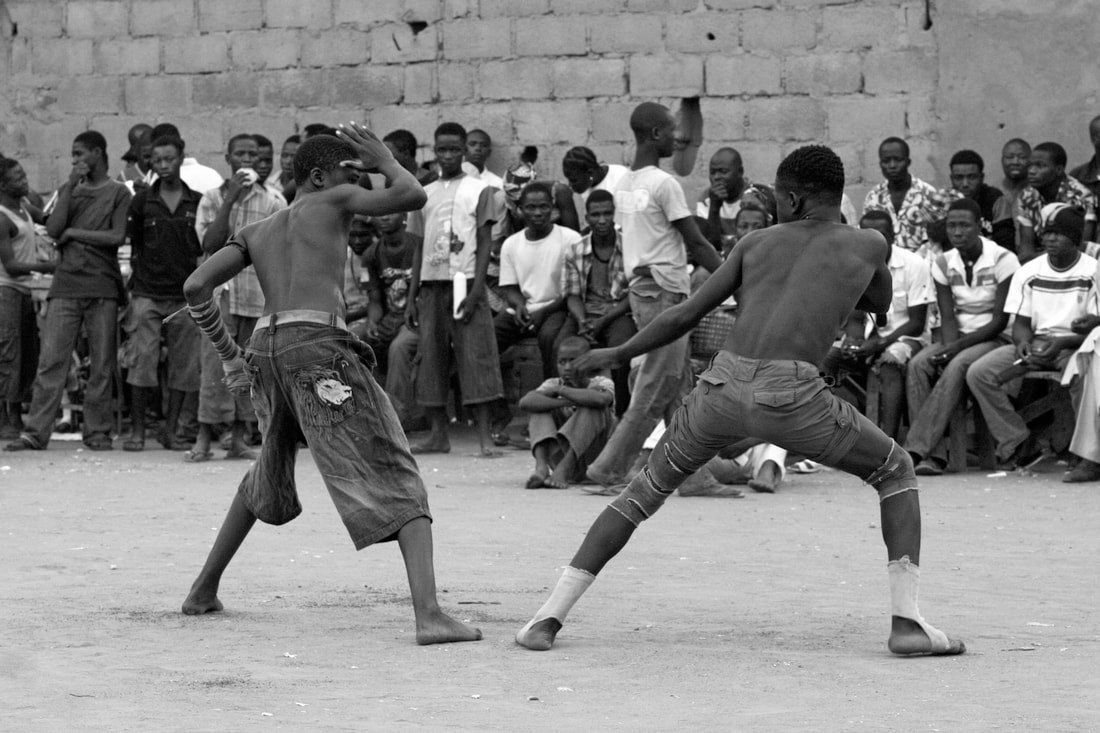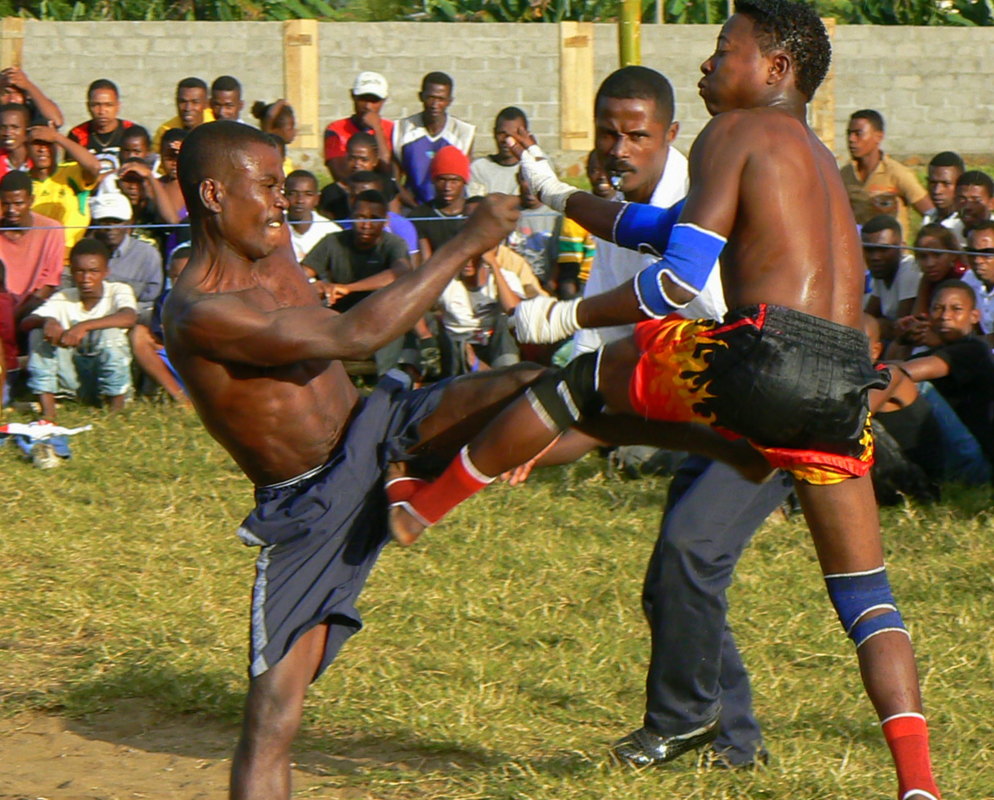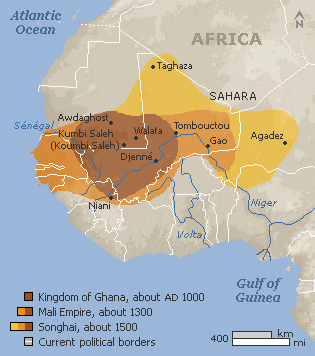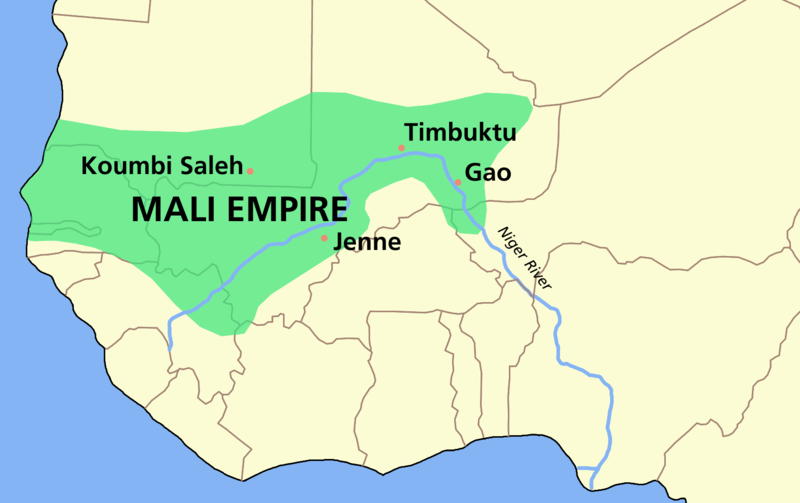|
West African Traditional and International Martial Arts
|
Dembe Boxing of West Africa
|
Dambe is a form of boxing associated with the Hausa people of West Africa. Historically, Dambe included a wrestling component, known as Kokawa, but today it is essentially a striking art. The tradition is dominated by Hausa butcher caste groups, and over the last century evolved from clans of butchers traveling to farm villages at harvest time, integrating a fighting challenge by the outsiders into local harvest festival entertainment. It was also traditionally practiced as a way for men to get ready for war, and many of the techniques and terminology allude to warfare. Today, companies of boxers travel, performing outdoor matches accompanied by ceremony and drumming, throughout the traditional Hausa homelands of northern Nigeria, southern Niger and southwestern Chad. The name "Dambe" derives from the Hausa word for "boxe", and appears in languages like Bole as Dembe. Boxers are called by the Hausa word "daæmaænga".
For more information, see: en.wikipedia.org/wiki/Dambe Also see below. |
In the southern part of the southwestern African nation of Angola one can find...
...Engolo or NGolo - A Kikongo word meaning strength, power
- a performance of ritual combat by various ethnic groups around the Cunene River.
The style of fighting involves various kicks, dodges, and leg sweeps, with an emphasis on inverted positions, i.e. with one or more hands on the ground. The first mention of Engolo in literature was made by Albano Neves e Sousa in a set of drawings demonstrating various techniques and their similarities to the Afro-Brazilian art form of Capoeira in the 1960s. Engolo is one of several African martial arts of the African Diaspora in the Americas.
Neves e Sousa described Engolo as part of a rite of passage, Omuhelo, between young boys vying for a bride in the contest, and whose techniques derived from the peculiar way in which Zebras fight among themselves. Research carried out by Dr. TJ Desch Obi finds that Engolo itself is not strictly performed for any one ritual, but as an element in various public and private performances.
Neves e Sousa described Engolo as part of a rite of passage, Omuhelo, between young boys vying for a bride in the contest, and whose techniques derived from the peculiar way in which Zebras fight among themselves. Research carried out by Dr. TJ Desch Obi finds that Engolo itself is not strictly performed for any one ritual, but as an element in various public and private performances.
Moraingy of western coastal Madagascar
|
Moraingy (Malagasy) or Moringue (French) is a weaponless, bare-fisted striking style of traditional martial art that originated during the Maroseranana dynasty (1675–1896) of the Sakalava Kingdom of western coastal Madagascar. It has since become popularized throughout Madagascar, but particularly in coastal regions, and has spread to neighboring Indian Ocean islands including Réunion, Mayotte, Comoros, Seychelles and Mauritius. Participation in this form of combat was originally limited to young men, allowing elders to judge their physical fitness and strength while providing an opportunity for the youth to gain prestige and test their abilities. Today, while the average age of participants is still between 10 and 35, young people of both genders may practice the sport. Participants are called kidabolahy (young men) or kidabo mpanao moraingy (young people who practice moraingy) and are widely respected and even feared by fellow villagers. In the North, they are called Fagnorolahy, and the assistants, magnafo. Moraingy matches must by tradition be accompanied by music (often salegy) to induce a trance-like state in the fighters and participants, contributing to the spiritual and communal experience of the fight. As part of this experience, participants typically engage in dances during and between the matches that are meant to provoke the supporters of the opposing party, while the crowd cheers and jeers loudly.
See: https://en.wikipedia.org/wiki/Moraingy |
Mali - West Africa
|
Present-day Mali was once part of three West African empires that controlled trans-Saharan trade: the Ghana Empire, the Mali Empire (for which Mali is named), and the Songhai Empire. During its golden age, there was a flourishing of mathematics, astronomy, literature, and art. At its peak in 1300, the Mali Empire covered an area about twice the size of modern-day France and stretched to the west coast of Africa. In the late 19th century, during the Scramble for Africa, France seized control of Mali, making it a part of French Sudan. French Sudan (then known as the Sudanese Republic) joined with Senegal in 1959, achieving independence in 1960 as the Mali Federation. Shortly thereafter, following Senegal's withdrawal from the federation, the Sudanese Republic declared itself the independent Republic of Mali. After a long period of one-party rule, a coup in 1991 led to the writing of a new constitution and the establishment of Mali as a democratic, multi-party state.
https://en.wikipedia.org/wiki/Mali The Mali Empire (Manding: Nyeni or Niani; also historically referred to as the Manden Kurufaba, sometimes shortened to Manden) was an empire in West Africa from c. 1230 to 1670. The empire was founded by Sundiata Keita and became renowned for the wealth of its rulers, especially Musa Keita. The Manding languages were spoken in the empire. It was the largest empire in West Africa and profoundly influenced the culture of West Africa through the spread of its language, laws and customs. Much of the recorded information about the Mali Empire comes from 14th-century North African Arab historian Ibn Khaldun, 14th-century Moroccan traveller Ibn Battuta and 16th-century Moroccan traveller Leo Africanus.” https://en.wikipedia.org/wiki/Mali_Empire This however was far from the end of Mali’s illustrious history. |
Mali - Traditional Martial Arts
Mali is a huge nation with a magnificent history. It once included what is now called Mauritania and Senegal - most of West Africa in fact. To become a great empire as Mali once was, they must have had a great military, and odds are they used martial arts training and styles from all over Africa which would have included Egypt, Senegal, Niger, Nigeria, etc. Without superior martial arts they could not have become or maintained the position of the preeminent West African Empire for nearly four hundred years. Thus, virtually surviving martial arts from West Africa - and probably all of Africa certainly had Malian roots.
∞∞∞
Lutte Traditionnelle has grown in organization and popularity throughout much of West Africa since the 1980s. Alongside national championships in many nations, several organizations have organised international tournaments, which in turn have necessitated a harmonization of rules. International competition takes place during the Jeux de la Francophonie and since 2000, is overseen by a coordinating body which organises the African Championship of lutte traditionnelle. In 2008, the Economic Community of West African States (ECOWAS) organised its first international championship for Lutte Traditionnelle in Dakar, inviting teams from eleven nations: Senegal, Mali, Niger, Nigeria, Burkina Faso, Guinea, Gambia, Guinée Bissau, Togo, Liberia and la Côte d'Ivoire. Nigeria won the competition, marking the first time an Anglophone nation (outside the Gambia) has won a major Lutte tourney.
https://en.wikipedia.org/wiki/Lutte_Traditionnelle
Laamb is considered a Senegalese martial art that combines wrestling and punching. This martial arts has become very popular in Senegal and often rivals the huge popularity of soccer.
https://blackbeltwiki.com/laamb
Engolo or NGolo (Kikongo word meaning strength, power) is a performance of ritual combat by various ethnic groups around the Cunene River in southern Angola. The style of fighting involves various kicks, dodges, and leg sweeps, with an emphasis on inverted positions, i.e. with one or more hands on the ground. The first mention of Engolo in literature was made by Albano Neves e Sousa in a set of drawings demonstrating various techniques and their similarities to the Afro-Brazilian art form of Capoeira in the 1960s. Engolo is one of several African martial arts of the African Diaspora in the Americas.
https://en.wikipedia.org/wiki/Engolo
Tahtib is an ancient Egyptian martial arts focused on stick fighting. It is thought to have been created around 2000-3000 BC. Drawings of this martial arts have been found on Egyptian tombs and pyramids. Tahtib is also known as Tahteeb.
https://blackbeltwiki.com/tahtib
Dambe is a West African martial arts focused primarily on boxing skills but contestants are also allowed to use kicking techniques...
Dambe, the boxing style of the Hausa people is most famous. When one looks at Dambe, one gets the feeling that it developed from spear fighting. In Dambe, one hand is called a “spear” and is tightly wrapped in twine or covered with a boxing glove. The other hand, called a “shield”, is left bare and is used for defense. Matches are divided into three rounds and kicking is allowed. The goal of Dambe is to score a “kill” by knocking your opponent to the ground, which can be difficult when you are limited to using only one hand.
This martial arts comes from the traditional training given to ancient African warriors (i.e. tribes in Nigeria, Niger and Chad). Even today, the lead hand is known as the spear and the rear hand as the shield.
https://blackbeltwiki.com/dambe
∞∞∞
Lutte Traditionnelle has grown in organization and popularity throughout much of West Africa since the 1980s. Alongside national championships in many nations, several organizations have organised international tournaments, which in turn have necessitated a harmonization of rules. International competition takes place during the Jeux de la Francophonie and since 2000, is overseen by a coordinating body which organises the African Championship of lutte traditionnelle. In 2008, the Economic Community of West African States (ECOWAS) organised its first international championship for Lutte Traditionnelle in Dakar, inviting teams from eleven nations: Senegal, Mali, Niger, Nigeria, Burkina Faso, Guinea, Gambia, Guinée Bissau, Togo, Liberia and la Côte d'Ivoire. Nigeria won the competition, marking the first time an Anglophone nation (outside the Gambia) has won a major Lutte tourney.
https://en.wikipedia.org/wiki/Lutte_Traditionnelle
Laamb is considered a Senegalese martial art that combines wrestling and punching. This martial arts has become very popular in Senegal and often rivals the huge popularity of soccer.
https://blackbeltwiki.com/laamb
Engolo or NGolo (Kikongo word meaning strength, power) is a performance of ritual combat by various ethnic groups around the Cunene River in southern Angola. The style of fighting involves various kicks, dodges, and leg sweeps, with an emphasis on inverted positions, i.e. with one or more hands on the ground. The first mention of Engolo in literature was made by Albano Neves e Sousa in a set of drawings demonstrating various techniques and their similarities to the Afro-Brazilian art form of Capoeira in the 1960s. Engolo is one of several African martial arts of the African Diaspora in the Americas.
https://en.wikipedia.org/wiki/Engolo
Tahtib is an ancient Egyptian martial arts focused on stick fighting. It is thought to have been created around 2000-3000 BC. Drawings of this martial arts have been found on Egyptian tombs and pyramids. Tahtib is also known as Tahteeb.
https://blackbeltwiki.com/tahtib
Dambe is a West African martial arts focused primarily on boxing skills but contestants are also allowed to use kicking techniques...
Dambe, the boxing style of the Hausa people is most famous. When one looks at Dambe, one gets the feeling that it developed from spear fighting. In Dambe, one hand is called a “spear” and is tightly wrapped in twine or covered with a boxing glove. The other hand, called a “shield”, is left bare and is used for defense. Matches are divided into three rounds and kicking is allowed. The goal of Dambe is to score a “kill” by knocking your opponent to the ground, which can be difficult when you are limited to using only one hand.
This martial arts comes from the traditional training given to ancient African warriors (i.e. tribes in Nigeria, Niger and Chad). Even today, the lead hand is known as the spear and the rear hand as the shield.
https://blackbeltwiki.com/dambe
Mali - International Martial Arts
Malian Kung-fu Wushu Federation
Address: S/C Direction National Des Sports Bp:91 Bamako Mali
Email: [email protected]
President: Boubacar COULIBALY
Secretary General: Samakoun SISSOKO
Taekwondo Mali
https://www.facebook.com/malitaekwondo/
[Note: When visiting developing countries it is always best in my opinion to first visit the Olympic Committee headquarters as they - and only they have the most up to date information on contact information for all Olympic sports.]
Olympic Committee Mali - Comité National Olympique et Sportif du Mali
Address: Villa n°1, Cité Ministérielle
Boulevard de l'Indépendance
B.P. 88
Bamako
Mali
Phone +223 20 23 94 02
Fax: +223 20 22 83 51
Email: [email protected]
Website: http://www.maliolympique.org/
President: Mr Habib SISSOKO
Secretary General: Mr Mohamed Oumar TRAORE
Also see:
Guild of the Silent Sword owes its name to the hero of the Soninke epic poem, Dausi. “The Dausi “was a poem of the history of the Soninke people and the rise and fall of their eternal city. Wagadu, according to historians, corresponds with the ancient West African empire of Ghana (850 C.E. - 1250 C.E.) in the area of Mali and Mauretania. Legend says, the city was protected by a great serpent named Bida...
http://www.silentsword.org/about.html
Address: S/C Direction National Des Sports Bp:91 Bamako Mali
Email: [email protected]
President: Boubacar COULIBALY
Secretary General: Samakoun SISSOKO
Taekwondo Mali
https://www.facebook.com/malitaekwondo/
[Note: When visiting developing countries it is always best in my opinion to first visit the Olympic Committee headquarters as they - and only they have the most up to date information on contact information for all Olympic sports.]
Olympic Committee Mali - Comité National Olympique et Sportif du Mali
Address: Villa n°1, Cité Ministérielle
Boulevard de l'Indépendance
B.P. 88
Bamako
Mali
Phone +223 20 23 94 02
Fax: +223 20 22 83 51
Email: [email protected]
Website: http://www.maliolympique.org/
President: Mr Habib SISSOKO
Secretary General: Mr Mohamed Oumar TRAORE
Also see:
Guild of the Silent Sword owes its name to the hero of the Soninke epic poem, Dausi. “The Dausi “was a poem of the history of the Soninke people and the rise and fall of their eternal city. Wagadu, according to historians, corresponds with the ancient West African empire of Ghana (850 C.E. - 1250 C.E.) in the area of Mali and Mauretania. Legend says, the city was protected by a great serpent named Bida...
http://www.silentsword.org/about.html
Clips from new stories about Mali, Martial Arts & Sports Palace
|
Shaolin Temple Monks visit Mali to promote the philosophy of peace
A delegation of five Shaolin Temple Monks arrived in Bamako, Mali, on 25 October 2014 for an exchange visit of three weeks. The monks’ stay in Bamako, then Segou from November 10 to 12, is designed to mentor and instill the values of peace, tolerance, kindness, self-discipline and self-control in young Malians and local populations, through the practice of martial arts. his initiative in favor of the culture of peace follows the signing of a partnership agreement in May 2014, between UNESCO and China World Peace Foundation, with the aim to promote cultural dialogue and cooperation between nations. African countries in post-conflict situations, and especially Mali due to the recent crisis, therefore represent a priority for all those involved in this program. “We called upon the monks from the Shaolin Temple to help amplify, through their experience, the culture of peace in each and every Malian. Who better than the Shaolin Monks to accomplish this task? Shaolin that has fascinated by its prowess in movies, Shaolin which everyone dreams of being a disciple”, said Mr. Housseïni Amion Guindo, the Minister of Sports during his opening speech of a large martial arts exhibition held at Bamako’s Palais des Sports by the Malian Ministry of Youth, UNESCO and the Chinese Embassy in Mali. The inaugural event was attended by over 3000 people from Bamako and surroundings. http://www.unesco.org/new/en/dakar/about-this-office/single-view/news/shaolin_temple_monks_visit_mali_to_promote_the_philosophy_of/ On a relatively unrelated note, there is also the Budapest Bamako race: At the end of each January, Bamako hosts the finish line to the gruelling trans-Sahara rally, the Budapest-Bamako [12]. Hundreds of rally cars and motorcycles arrive in the city on the last Sunday of January. http://www.budapestbamako.org/en https://wikitravel.org/en/Bamako |
Bamako, Mali (PANA) - The Malian President, Ibrahim Boubacar Keita, at the weekend inaugurated a 5,000-seat Sports Palace in the new administrative and business district of Hamdallaye ACI 2000 (West of Bamako), PANA learnt from sports source Monday.
Designed to host competitions in basketball, handball, volleyball, karate, taekwondo and judo, the palace covers an area of 3.8 hectares. Fully air conditioned, the sports Palace has facilities for playground, a boxing gym, three martial arts halls, two changing rooms for teams, two reheating rooms per team, one changing room for referees, ticket offices, premises for the administration, shops, stores and refreshment rooms. Upstairs, the sports Palace has a presidential lounge, lounge for officials, bleachers and a report room. The Malian government spent 9 billion FCFA on the palace which was built by China's overseas general Company (COVEC). PANA reports that the palace was inaugurated only a few days before the start of the peace, friendship and solidarity tournament, scheduled for 20-28 February in Bamako. The solidarity games will be attended by 800 athletes from 16 African, European and Asian countries. 17Feb2014 http://www.panapress.com/Mali--President-Keita-opens-5,000-seat-sports-palace-in-Bamako--13-897835-0-lang2-index.html |
For a bit more about Malian history, see: Greatest African Warriors on menu above or just click:
fightingartsafrica.weebly.com/greatest-afrikan-warriors.html
fightingartsafrica.weebly.com/greatest-afrikan-warriors.html
Proudly powered by Weebly



